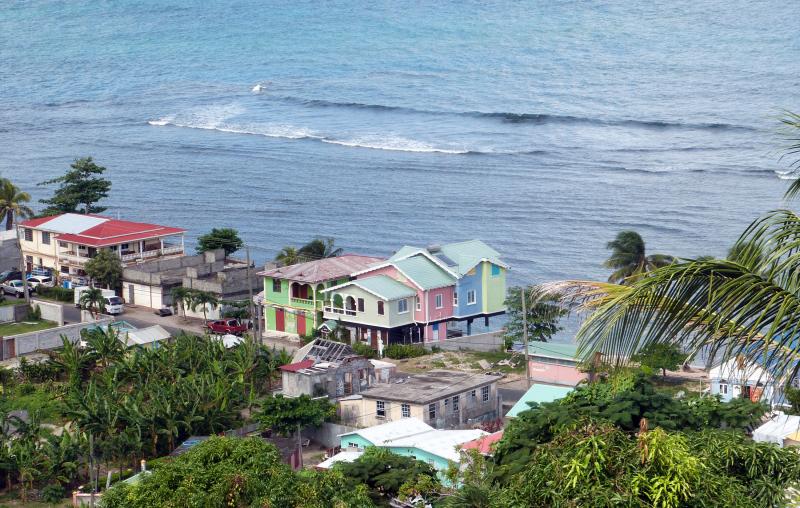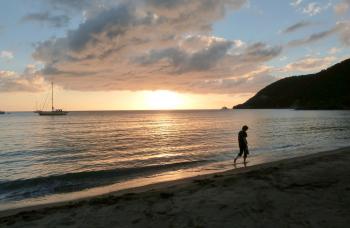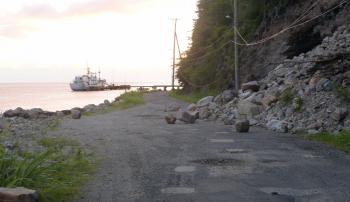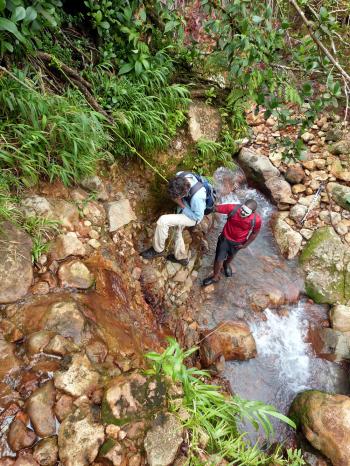Visiting the tiny island of Dominica in the aftermath of devastating storms
This article appears on page 32 of the September 2019 issue.
My wife, Lois, and I first considered visiting Dominica after being seduced by Paul Crask’s “Dominica” Brandt Travel Guide, but events got in the way — specifically, tropical storm Erika (2015) and hurricane Maria (2017), each of which devastated the country.
Nevertheless, Dominica retained its appeal, and in the spring of 2018 we asked ourselves, “Would it be wise to visit a country so recently overwhelmed? Would it be safe or even minimally comfortable? Would a visit be considered intrusive?”
Full disclosure — I grew up with the personal experience of hunkering down and hoping for the best during Category 3 Carol (1954), Category 3 Edna (two weeks later) and Category 2 Donna (1960), so the thought of damage wrought by Category 5 Maria was especially frightful.
Maria, the nasty Sept. 19, 2017, hurricane with sustained 165-mph winds, damaged more than 85% of the island’s houses leaving thousands of residents displaced. Sixty-five fatalities were confirmed.
And tropical storm Erika’s downpour, although downgraded from hurricane status, had left nearly 80% of Dominica’s 73,000 residents without power. Thirty people were killed and 20, injured; in addition, 574 people were left homeless and many communities were cut off from rescue efforts for months.
Prior to our visit, I researched the extent of the remaining damage to ascertain whether our presence would hinder rather than help this country’s revival. I’m happy to report that tourism is not only welcomed but enthusiastically encouraged. Dominica, The Nature Island, is back!
During our Nov. 15-30, 2018, visit, we experienced tolerable inconveniences — no cable TV, spotty Wi-Fi and some roads recovering from recent landslides — but we did enjoy reliable electricity, clean water and manageable driving. Rebuilding is ongoing, and we were impressed with the community-wide engagement.
Some background
Tiny Dominica (290 square miles) is frequently confused with the Dominican Republic, which is nearly 19,000 square miles. The two could not be more different.
As the youngest island in the Lesser Antilles, Dominica is also one of the most seismically active; it’s home to nine of the 21 potentially active volcanoes in the island chain.
French colonists from nearby Guadeloupe and Martinique established plantations there in the 1690s, but when Great Britain won possession in 1763 as a concession from the Seven Years’ War, English became its official language. However, there are still many French Creole speakers.
Dominica gained independence in 1978 and remains one of the smallest independent republics in the world.
Getting there
Our round-trip Kansas City-Miami-San Juan-Dominica flights on American Airlines (San Juan, Puerto Rico, to Dominica was operated by Seaborne Airlines) cost us $748 each, plus $25 for baggage, through Cheapo Air (www.cheapoair.com). I was pleasantly surprised that, in spite of their name, Cheapo provided excellent follow-up support.
Most flights were on time. The Douglas-Charles International Airport can accommodate only 30-seat Saab twin-engine turboprops (no jets) and only from adjacent islands, but the flights are not always on schedule.
The reason — Dominica’s unpredictable weather — was obvious to us after our 1½-hour flight from San Juan was suddenly aborted on approach due to severe weather. We returned to San Juan, waiting an hour for the weather to clear before retracing our route. Subsequently, our anticipated 1½-hour flight took more than six hours.
Arriving late in the day, we were met by an agent of QB Vehicle Rentals (Roseau, Dominica; www.qbvehicles.com), who provided us with our local driver’s license ($20) and a Honda something for $45 a day. A testament to Dominica’s rugged terrain is that all rental vehicles feature 4-wheel drive. They are also well used; ours had clocked over 100,000 miles.
Marigot to Scotts Head
Through Airbnb (www.airbnb.com), we booked two apartments on the Atlantic side of the island, at Marigot and Calibishie, and two on the Caribbean side, at Scotts Head and Portsmouth.
It was dark and lightly raining as we set off to find our first accommodation, which proved to be challenging. Lois is always the designated driver and I am responsible for navigating, but we had not anticipated such difficulty in finding our first Airbnb rental.
First, we were unable to make cell phone contact. In fact, our cell never worked during our visit. So at one point we pulled into a gas station, where I asked the clerk to please call our “JNR” Airbnb. The station owner said that Rushell, our contact, was his cousin and that another relative would lead us to our residence. In minutes, we were comfortably settled in.
This was our first experience with Dominican hospitality.
Our first three days were at JNR’s Overnighter ($50 per night), a 2-bedroom hilltop apartment with a stunning view of the Atlantic. James and Rushell (“J-N-R”) were delightful hosts, and the apartment met our expectations.
We did experience what I have known growing up as squalls, rapidly appearing wind/rain storms, on the Atlantic side of the island. Imagine a quiet evening of reading when, suddenly. a roar materializes and you have to run to close the windows lest the wind-driven rain soaks your house. It happened several times. and as quickly as it occurred, it dissipated.
From our base in Marigot, we toured Kalinago Territory, an autonomous self-governing region where 3,000 descendents of the only surviving pre-Columbian indigenous people live.
Next we crossed the island to Scotts Head, located at the extreme southern point, which features a narrow isthmus leading to Cachacrou, a stunning, 150-foot-high peninsula.
The phone contact number for our Airbnb there didn’t work, but we had amazing assistance from neighbors, who helped us find the custodian with the key for our four nights at Aquatic Apartments ($50 per night).
Scotts Head has been slower to recover from Maria than other areas and we were without Wi-Fi for five days (which was nice). Our custodian still didn’t have water at her home.
This was our base for the half-hour drive to the capital, Roseau, and for several adventurous excursions, including a 150-foot climb up to the Cachacrou lighthouse.
Boiling Lake trek
When I researched how Maria had impacted the world-class Boiling Lake trail, reports were that it had been restored “enough.” The tourist office in Roseau assured us that it was doable, so we retained a guide ($50 per person) for the next day.
Warning: Do not consider this trek without a qualified guide. The trail is poorly marked, and there is no reliable GPS signal unless you have a satellite phone. Our guide, Chadee, apologized for having to backtrack several times, saying that parts of the trail were passable on recent treks but now were washed out.
The 8-mile hike to Boiling Lake and back is the ultimate Dominica challenge, and 348 TripAdvisor reviewers had given it a 5-star rating. What is billed as a 6-hour trek under normal circumstances turned into a 9-hour, 40-minute slog on a slippery, interrupted trail.
Maria not only corrupted the trail on impact but left behind weakened areas that would fail in subsequent normal rainfalls, as we soon found out. Temporary ropes helped us get over the many washed-out parts of the trail, but it was an exhausting journey. Frequent rain showers that day didn’t help the already slippery footing.
The walk through the regrettably named but quite beautiful Valley of Desolation was dramatic. Steaming fumaroles in the area created brilliantly colored pools, some hot enough to boil eggs (or feet), so each step had to be carefully considered.
We arrived at the rim of the crater surrounding the lake in a shower and waited for the fog to clear for a photo of the impressive, churning, 200-foot-wide boiling cauldron below. After a quick lunch and photos, it was time for the descent.
The hike back was even more challenging due to our exhaustion and the impending darkness, but we arrived shortly after sunset safe and mostly sound. However, we were in recovery for several days.
Winding down
Our three nights at Safari Apartments (www.safariapartment.com) in Portsmouth ($59 per night) included much-appreciated A/C and strong Wi-Fi, along with beautiful sunsets.
We enjoyed touring Fort Shirley on a quiet Sunday morning and walking along the tiny, sandy Purple Turtle Beach. Nota bene: Dominica, with steep volcanic cliffs, has few beaches, and most are rocky.
Our last three nights, in Calibishie, were at the charming Riversideview House ($50 per night; dominica housing.com/riversideview-house), just a half hour from the airport.
During our time on the island, we saw no billboards or signage to hinder the beautiful views, but the lack of directional signs made finding places very difficult. Only in Roseau were there street signs; even main highways were unmarked.
Our fondest memory of Dominica has to be the sincere friendliness of the people. As experienced travelers, we quickly ascertain the degree of caution we need to take in a new destination, and we felt more comfortable throughout Dominica than in our own neighborhood back home. Adults consistently offered genuine, friendly greetings; storekeepers engaged in conversation, even after a sale; guides were professional, and everyone we met was proud of their country. This vibe made us feel very welcomed.
We urge readers to enjoy Dominica before it loses its innocent nature.




